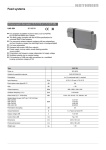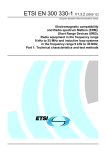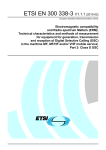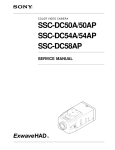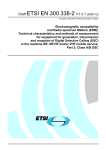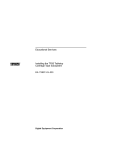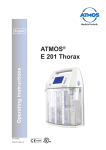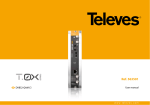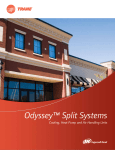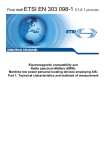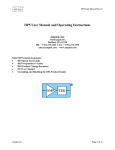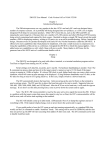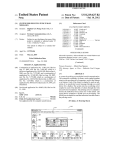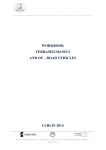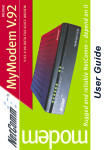Download TS 102 252 V1.1.1
Transcript
ETSI TR 102 252 V1.1.1 (2003-10) Technical Report Digital Video Broadcasting (DVB); Guidelines for implementation and use of the control channel for SMATV/MATV distribution systems E u ro p e a n B ro a d c a s tin g U n io n U n io n E u ro p é e n n e d e R a d io -T é lé vis io n E B U ·U E R 2 ETSI TR 102 252 V1.1.1 (2003-10) Reference DTR/JTC-DVB-152 Keywords broadcasting, control, digital, DVB, SMATV, video ETSI 650 Route des Lucioles F-06921 Sophia Antipolis Cedex - FRANCE Tel.: +33 4 92 94 42 00 Fax: +33 4 93 65 47 16 Siret N° 348 623 562 00017 - NAF 742 C Association à but non lucratif enregistrée à la Sous-Préfecture de Grasse (06) N° 7803/88 Important notice Individual copies of the present document can be downloaded from: http://www.etsi.org The present document may be made available in more than one electronic version or in print. In any case of existing or perceived difference in contents between such versions, the reference version is the Portable Document Format (PDF). In case of dispute, the reference shall be the printing on ETSI printers of the PDF version kept on a specific network drive within ETSI Secretariat. Users of the present document should be aware that the document may be subject to revision or change of status. Information on the current status of this and other ETSI documents is available at http://portal.etsi.org/tb/status/status.asp If you find errors in the present document, send your comment to: [email protected] Copyright Notification No part may be reproduced except as authorized by written permission. The copyright and the foregoing restriction extend to reproduction in all media. © European Telecommunications Standards Institute 2003. © European Broadcasting Union 2003. All rights reserved. TM TM TM DECT , PLUGTESTS and UMTS are Trade Marks of ETSI registered for the benefit of its Members. TM TIPHON and the TIPHON logo are Trade Marks currently being registered by ETSI for the benefit of its Members. TM 3GPP is a Trade Mark of ETSI registered for the benefit of its Members and of the 3GPP Organizational Partners. ETSI 3 ETSI TR 102 252 V1.1.1 (2003-10) Contents Intellectual Property Rights ................................................................................................................................5 Foreword.............................................................................................................................................................5 1 Scope ........................................................................................................................................................6 2 References ................................................................................................................................................7 3 Abbreviations ...........................................................................................................................................7 4 Reference model.......................................................................................................................................8 5 Configurations of SMATV/MATV distribution systems.........................................................................9 5.1 5.2 5.3 5.3.1 5.3.2 5.3.3 5.3.4 5.3.5 5.4 6 Current SMATV/MATV implementation ..........................................................................................................9 SMATV/MATV implementation based on the control channel.......................................................................10 Typical SMATV/MATV topologies ................................................................................................................11 SMATV/MATV installations with resistive taps........................................................................................11 SMATV/MATV installations with inductive directional taps ....................................................................12 SMATV/MATV installations with d.c. coupled inductive taps..................................................................12 "Multiswitches equipped" SMATV installations........................................................................................13 Intermediate amplification ..........................................................................................................................13 Performance of typical SMATV/MATV installations in the Control Channel frequency range......................13 Control Channel protocol .......................................................................................................................15 6.1 6.2 6.3 7 Basic features ...................................................................................................................................................15 CRC decoding implementation ........................................................................................................................16 Extension of the message length ......................................................................................................................17 Control Channel bus...............................................................................................................................17 7.1 7.1.1 7.2 7.2.1 7.2.2 8 Implementation of the 22 kHz bus ...................................................................................................................17 Example for a 22 kHz bus interface circuit.................................................................................................19 Implementation of the RF control channel bus.................................................................................................20 ACK and answer to a command .................................................................................................................20 Control channel frequencies in networks with intermediate amplification.................................................20 Performance evaluation of the multiaccess system ................................................................................21 8.1 8.2 8.2.1 8.2.2 8.2.3 8.2.4 9 kHz Control Channel bus .................................................................................................................................21 RF Control Channel bus ...................................................................................................................................23 System description......................................................................................................................................23 Traffic hypothesis .......................................................................................................................................23 Theoretical analysis ....................................................................................................................................23 Collision scenario for repeated transmissions.............................................................................................25 Receiver and Head-end implementation aspects....................................................................................25 9.1 9.2 Physical Layer based on a 22 kHz bus .............................................................................................................26 Physical Layer based on a RF bus ....................................................................................................................26 Annex A: Installation and operation routines..............................................................................................28 A.1 Introduction ............................................................................................................................................28 A.1.1 A.1.2 A.1.3 A.1.4 A.1.4.1 A.1.4.2 A.1.4.3 A.2 A.2.1 A.2.2 A.2.3 Network diagram..............................................................................................................................................28 PIN_code allocation .........................................................................................................................................29 Assumptions .....................................................................................................................................................29 Installation operation........................................................................................................................................29 Automatic Installation.................................................................................................................................29 Pre-setting ...................................................................................................................................................29 Installation Routine.....................................................................................................................................30 Operation................................................................................................................................................32 Manual Installation...........................................................................................................................................32 Pre-setting.........................................................................................................................................................32 Installation Routine .........................................................................................................................................33 ETSI 4 A.2.4 ETSI TR 102 252 V1.1.1 (2003-10) Operation..........................................................................................................................................................34 Annex B: DiSEqC Commands allowing compatibility with existing systems ...........................................35 B.1 SMATV_Installation..............................................................................................................................35 B.2 Headend_Call_Out_of_Standby.............................................................................................................35 B.3 Headend_Tuning_Parameters ................................................................................................................35 B.4 Master_Switch_to_Standby....................................................................................................................36 B.5 SMATV_Installation_reply....................................................................................................................36 B.6 Headend_Call_Out_of_Standby_reply ..................................................................................................37 B.7 General_Call_for_STB(s) ......................................................................................................................37 B.8 Service_Commands_for_the_Head-end.................................................................................................37 B.9 Head-end installation, tuning, etc. procedure.........................................................................................37 Annex C: Subset of commands that FLEXIMATV recommends for implementation of the control channel protocol.............................................................................................39 C.1 Framing bytes .........................................................................................................................................39 C.2 Commands..............................................................................................................................................39 Annex D: Common bus implementation ......................................................................................................40 D.1 Introduction ............................................................................................................................................40 D.2 Physical layer .........................................................................................................................................40 D.3 Message structure...................................................................................................................................41 D.4 Bus protocol ...........................................................................................................................................41 Annex E (informative): Bibliography ...........................................................................................................44 History ..............................................................................................................................................................45 ETSI 5 ETSI TR 102 252 V1.1.1 (2003-10) Intellectual Property Rights IPRs essential or potentially essential to the present document may have been declared to ETSI. The information pertaining to these essential IPRs, if any, is publicly available for ETSI members and non-members, and can be found in ETSI SR 000 314: "Intellectual Property Rights (IPRs); Essential, or potentially Essential, IPRs notified to ETSI in respect of ETSI standards", which is available from the ETSI Secretariat. Latest updates are available on the ETSI Web server (http://webapp.etsi.org/IPR/home.asp). Pursuant to the ETSI IPR Policy, no investigation, including IPR searches, has been carried out by ETSI. No guarantee can be given as to the existence of other IPRs not referenced in ETSI SR 000 314 (or the updates on the ETSI Web server) which are, or may be, or may become, essential to the present document. Foreword This Technical Report (TR) has been produced by Joint Technical Committee (JTC) Broadcast of the European Broadcasting Union (EBU), Comité Européen de Normalisation ELECtrotechnique (CENELEC) and the European Telecommunications Standards Institute (ETSI). NOTE: The EBU/ETSI JTC Broadcast was established in 1990 to co-ordinate the drafting of standards in the specific field of broadcasting and related fields. Since 1995 the JTC Broadcast became a tripartite body by including in the Memorandum of Understanding also CENELEC, which is responsible for the standardization of radio and television receivers. The EBU is a professional association of broadcasting organizations whose work includes the co-ordination of its members' activities in the technical, legal, programme-making and programme-exchange domains. The EBU has active members in about 60 countries in the European broadcasting area; its headquarters is in Geneva. European Broadcasting Union CH-1218 GRAND SACONNEX (Geneva) Switzerland Tel: +41 22 717 21 11 Fax: +41 22 717 24 81 Founded in September 1993, the DVB Project is a market-led consortium of public and private sector organizations in the television industry. Its aim is to establish the framework for the introduction of MPEG-2 based digital television services. Now comprising over 200 organizations from more than 25 countries around the world, DVB fosters market-led systems, which meet the real needs, and economic circumstances, of the consumer electronics and the broadcast industry. ETSI 6 1 ETSI TR 102 252 V1.1.1 (2003-10) Scope The present document provides the first guidance to manufacturers, network operators and service providers on equipment design for the use of the Control Channel for SMATV/MATV systems, whose baseline specification is given in TS 101 964 [1]. The Control Channel for SMATV/MATV distribution systems is intended to provide remote control of the head-end device from the user's terminal through a set of commands in a closed in-building environment for the delivery of broadcast services. Furthermore, the Control Channel allows each single user of the building to autonomously decide on the possibility of receiving digital broadcasting services through the community installation, without the need of authorisation from the other users. So the user connected via the in-building cable network can access the broadcast services, satellite and terrestrial, as in the case of "individual reception". The Control Channel protocol is based on DiSEqC [2] to maintain compatibility with existing products and has the further advantage of being sufficiently flexible to allow for future extensions, if and when needed. The structure of the Control Channel message ensures a robust transmission mechanism. SMATV/MATV distribution systems, as described in EN 300 473 [3], represent a solution widely adopted for inbuilding delivery of DVB signals (both satellite and terrestrial) through collective installations. The adoption of the Control Channel specification, which has been defined in accordance with the commercial requirements given in DVB-TM 2342 (see bibliography), offers an alternative cost-effective solution to the current implementation of SMATV/MATV systems, especially for the case of small and medium size installations, allowing the delivery of DVB TSs/multiplexes without the constraints of the limited bandwidth available in the installation. The technical specification of the Control Channel system (see TS 101 964 [1]) describes the message structure and the set of commands and coding used for remote controlling the Head-end of the SMATV/MATV distribution system. The specification covers both the approaches adopted for the delivery of satellite signals as identified in EN 300 473 [3], i.e. transmodulation from QPSK to QAM (System A) and direct distribution in QPSK after frequency conversion (System B), as well as the remote control of other head-end devices for broadcast services. The specification also takes into account the requirements from EN 301 790 [4] in order to achieve the best commonality and ensure the minimum functionality required for operating via the SMATV systems the satellite interactive terminals. Although primarily focused on SMATV systems for delivery of satellite DVB services, the Control Channel shall also be applicable to MATV systems currently used for terrestrial broadcasting services via VHF/UHF and microwave. The Physical layers of the Control Channel system, described in clauses A.1 and A.2 of TS 101 964 [1], allow for a general use of the Control Channel in the whole range of SMATV/MATV distribution systems, having different topologies and characteristics. The transmission protocol providing the communication link between the user's terminal and the head-end device makes use of the same commands and coding for both physical layers. Furthermore, since the Control Channel capacity is shared among all the user terminals, a "multiaccess" approach is adopted in order to guarantee adequate access time to the selected service. The solution presented in clause A.1 of TS 101 964 [1], which is based on the use of a 22 kHz bus, is suitable for the case of small SMATV/MATV installations using d.c. coupled elements. The solution presented in clause A.2 of TS 101 964 [1], which is based on the use of an RF bus in a frequency range above 10 MHz, provides the capability to pass through community installations using inductive components. So, this second solution potentially allows for a transparent introduction of the Control Channel in most existing SMATV/MATV systems. The present document gives details on the technical parameters and guidelines for system implementation, and provides an evaluation of the performance of the multiaccess schemes adopted for the 22 kHz bus and the RF Control Channel bus, as well as a better knowledge of the features and possibilities offered by the Control Channel protocol . FLEXIMATV Project IST-2000-28695 has been devoted to develop technological solutions based on the DVB control channel specification, aiming at consolidating that European standard, introducing any necessary enhancements and producing clear guidelines on the best practices for implementing DVB control channel systems. These contributions have been included in the present document. Consequently, FLEXIMATV has been aimed at the consolidation of a mature standard supported and endorsed by the analysis and studies, development of industrial solutions, confirmation of suitable performances through appropriate tests in laboratory and in real installations. ETSI 7 2 ETSI TR 102 252 V1.1.1 (2003-10) References For the purposes of this Technical Report (TR) the following references apply: [1] ETSI TS 101 964: "Digital Video Broadcasting (DVB); Control Channel for SMATV/MATV distribution systems; Baseline Specification". [2] Eutelsat: "DiSEqC Bus Functional Specification version 4.2", February 25, 1998 . [3] ETSI EN 300 473: "Digital Video Broadcasting (DVB); Satellite Master Antenna Television (SMATV) distribution systems". [4] ETSI EN 301 790: "Digital Video Broadcasting (DVB); Interaction channel for satellite distribution systems". [5] IEC 60728-1: "Cabled distribution system for sound and television signals - Part 1: Methods of measurement and system performance". [6] ETSI EN 300 421: "Digital Video Broadcasting (DVB); Framing structure, channel coding and modulation for 11/12 GHz satellite services". [7] ETSI EN 300 429: "Digital Video Broadcasting (DVB); Framing structure, channel coding and modulation for cable systems". [8] ETSI EN 300 744: "Digital Video Broadcasting (DVB); Framing structure, channel coding and modulation for digital terrestrial television". 3 Abbreviations For the purposes of the present document, the following abbreviations apply: ACK CRC DC DiSEqC DVB-TS FDMA FEC FSK HE HeCD HED HP IDU IF LNB LP MATV MID MMI ODU OFDM PIN PWK QAM QPSK RF SID SMATV STB TDMA ACKnowledge Cyclic Redundancy Check Direct Current Digital Satellite Equipment Control Digital Video Broadcasting-Transport Stream Frequency Division Multiple Access Forward Error Correction Frequency Shift Keying Head End Head-end Control Device Head End Device High Priority InDoor Unit Intermediate Frequency Low Noise Block Low Priority Master Antenna TV Master IDentifier Man-Machine Interface OutDoor Unit Orthogonal Frequency Division Multiplexing Personal Identification Number Pulse Width Keying Quadrature Amplitude Modulation Quaternary Phase Shift Keying Radio Frequency Slave IDentifier Satellite Master Antenna TV Set Top Box Time Division Multiple Access ETSI 8 UHF VHF 4 ETSI TR 102 252 V1.1.1 (2003-10) Ultra High Frequency Very High Frequency Reference model The reference model representing the Control Channel solution adopted by SMATV/MATV distribution systems, and specified in TS 101 964 [1], is shown in figure 1. Head -end device Local bus In -building Hea d-end unit Module 1 (e.g. QPSK to QAM , IF to IF) Module 2 … Module N HeCD SMATV/MATV Cable Network Broadcast Channel User -allocated RF Channel (e.g. 8 MHz) Set-Top-Box Control Channel (Narrow -band carrier) Control Channel Interface Figure 1: Simplified functional block diagram of the in-building SMATV/MATV System using a Control Channel The system approach is based on the allocation of two independent logical channels to each user terminal: • Broadcast Channel: a unidirectional broadband delivery channel for video, audio and data services. • Control Channel: a bi-directional narrow-band channel established between the head-end device and the user's terminal for control and signalling purposes. This logical functionality is performed by allocating to each user terminal (STB) an individual RF channel on the in-building cable network for the delivery of the DVB services. Each service/DVB Transport Stream is remotely selected by the user's terminal controlling the head-end device, installed in the building (e.g. QPSK/QAM transmodulator, QPSK/QPSK frequency converter), via a suitable set of commands provided by the Control Channel, which is unique for all the users of the network. All the equipment which are operated via the Control Channel, i.e. the head-end devices and the user's terminals, are connected through the same coaxial SMATV/MATV installation. The RF channel can make use of any available frequency slots within the in-building cable network in the frequency range between about 30 MHz and 2150 MHz in accordance with IEC 60728-1 [5]. The bandwidth of the RF channel depends on the characteristics of the delivery solution, i.e. typically 33 MHz in case of QPSK satellite signals, 7 MHz or 8 MHz in case of QAM satellite and OFDM terrestrial signals. In order to provide remote control of the Head-end, both the user terminal and the Head-end device are equipped with a suitable Control Channel interface implementing physical layer and protocol management. This interface at the STB is implemented using a modem, which receives the commands from the STB and sends them to the head-end. The user's head-end device then selects the appropriate service/DVB TS. The decision of whether to include the modem in the STB is up to the STB manufacturer and therefore outside the scope of these guidelines. ETSI 9 ETSI TR 102 252 V1.1.1 (2003-10) The Control Channel Interface at the head-end can be implemented in two different ways: • Embedding the modem in the head-end devices; • Adding a new device (Head-End Control Device, HeCD), which receives the commands coming from every STB in the network and sends them to the appropriate associated devices which are linked to the HeCD by means of the local bus. Both solutions are compatible and can be used simultaneously. 5 Configurations of SMATV/MATV distribution systems The present document considers the introduction of the Control Channel solution in the two SMATV satellite distribution systems (A and B) identified by DVB EN 300 473 [3], as well in MATV terrestrial installations. The basic architecture is shown in figure 2. Three main functional blocks are identified: parabolic or/and terrestrial antenna(s), head-end, in-building cable network. QPSK/QAM Transmodulators QPSK/QPSK Frequency Converters Head-End Unit ... Line Splitter User Tap Cable distribution network User Outlets Figure 2: Typical architecture of in-building SMATV/MATV distribution systems 5.1 Current SMATV/MATV implementation The distribution of satellite digital signals via SMATV systems is currently carried out adopting the two basic approaches identified by DVB EN 300 473 [3]: 1) SMATV System A: This approach consists of the transmodulation at the Head-end from satellite Quaternary Phase Shift Keying (QPSK) signals, as defined in EN 300 421 [6], to a Quadrature Amplitude Modulation (QAM) scheme. 2) SMATV System B: This approach consists of distribution of QPSK satellite signals, as defined in EN 300 421 [6], after frequency conversion of the received satellite signal into a frequency band appropriate to the characteristics of the distribution network (e.g. satellite 1st IF and/or extended S-band). The use of the System A or System B approaches depends on the technical performance and cost trade-offs required in each particular situation. ETSI 10 ETSI TR 102 252 V1.1.1 (2003-10) Figure 3 shows a possible channel allocation for the delivery of DVB services and terrestrial TV through in-building cable distribution networks based on the following approach: • For SMATV System A: use of the available frequency channels (e.g. 7 MHz ÷ 8 MHz) in existing in-building cable systems in the frequency range between about 30 MHz and 862 MHz. • For SMATV System B: use of the 1st IF (950 MHz ÷ 2 150 MHz) in new in-building cable systems for the delivery of up to 30 DVB-S channels in QPSK (33 MHz / channel); need to rebuild the existing in-building system using network components suitable for high frequency operation (taps, cable, outlets, etc.); potential use of the extended S-band in existing installations allowing the delivery of up to 6 DVB-S channels. • For Terrestrial analogue and DVB-T signals: use of the VHF/UHF bands. UHF VHF band I PAL 47 68 extended superband band III FM radio SATELLITE CHANNELS TERRESTRIAL CHANNELS SATELLITE CHANNELS TERRESTRIAL CHANNELS PAL DVB-T 174 30 DVB-C channels (64-QAM) 230 satellite 1st IF bands IV, V PAL DVB-T 470 30 DVB-S channels (QPSK) 862 950 2 150 f (MHz) Figure 3: Possible channel allocation for the delivery of DVB services in SMATV/MATV installations 5.2 SMATV/MATV implementation based on the control channel In both SMATV Systems A and B the number of devices at the Head-end unit (frequency converters and transmodulators) is proportional to the number of satellite channels/multiplexes (i.e. DVB Transport Streams). It means that the delivery of each DVB-TS requires the allocation of a corresponding RF channel on the cable with the penalty of the need of increased bandwidth availability when new services/TSs are delivered through the network, and with the constraints on the maximum number of services which can be delivered via a single cable network. Furthermore, in case the number of users in the building willing to access the new services is limited (e.g. in small and medium size installations), the implementation cost can not be equally shared among the total number of users, with significant penalty for those interested. The adoption of the Control Channel solution allows each single user of the building to autonomously decide on the possibility of receiving digital broadcasting services through the community installation without the other users' authorisation. In addition it allows the delivery of DVB-TSs / multiplexes without the constraints of the limited bandwidth available in the single cable installations. For the case of satellite reception, with reference to figure 3, in the Control Channel solution the frequency resources of the extended S-band (230 MHz ÷ 470 MHz) and/or of the 1st IF band (950 MHz ÷ 2 150 MHz) can be exploited for the delivery to the individual users, on a single cable, of all the DVB TSs/multiplexes provided by the satellite transponders made available at the Head-end (up to 30 user terminals for each frequency range). ETSI 11 5.3 ETSI TR 102 252 V1.1.1 (2003-10) Typical SMATV/MATV topologies The Control Channel baseline specification adopts two Physical Layers (see clauses A.1 and A.2 of TS 101 964 [1]) in order to cover the whole range of SMATV/MATV distribution systems, having different topologies and characteristics (i.e. available frequency bandwidth, type of network components, user taps, etc.). With reference to figure 2, the SMATV/MATV distribution systems currently adopt two technological solutions: a) Use of passive components (splitters, user taps) in the common parts of the network. The user taps are connected between themselves with only one cable, and can be implemented with resistive or inductive elements. In some case the user tap is directly included in the user outlet (through outlet). In order to provide the viewers with the maximum number of attractive channels, the large majority of SMATV installations using passive components are equipped with channel pre-selection at the Head-end. b) Use of multiswitch in the common parts of the network. The multiswitches are connected between themselves with a certain number of cables (five or nine in some cases). One of these cables carries the terrestrial channels and the others, connected to a four output LNB (two LNBs in case of nine cables) carry the satellite channels. Each end-user is connected to a multiswitch with only one cable. In the following clauses the main technical characteristics of some SMATV/MATV installation are reported in terms of frequency response, for the purpose of identifying the best implementation of the Control Channel system. 5.3.1 SMATV/MATV installations with resistive taps Installations which make use of resistive taps were used in the past and are still used in old installations. Resistive taps have, in general, poor performance because of the impedance mismatching and the low isolation among the output ports. The number of users in these installations is limited to ten to twelve. Networks using resistive taps are also very sensitive to the matching condition of the outlet termination. Figure 4 shows a typical resistive tap, supplying the signal from the main cable line to the user outlets. Table 1 reports the values of the attenuation among its ports. Theoretically the frequency response of the resistive tap is frequency independent. I O1 560 Ω 560 Ω 150 Ω O2 150 Ω O Figure 4: Circuit of a typical resistive tap Table 1: Theoretical attenuations of the resistive tap of figure 4 Through Loss (I→O) Tap Loss (I→ →O1,O2) Directional Loss (O1,O2→I) Mutual Isolation (O1→O2) ETSI 0 dB 21,7 dB 21,7 dB 46,3 dB 12 5.3.2 ETSI TR 102 252 V1.1.1 (2003-10) SMATV/MATV installations with inductive directional taps Inductive directional taps are currently used in recent installations. These devices have different electrical characteristics according to the signal propagation direction (directional couplers) and show a low transit attenuation and a high isolation between the output and the user outlet, ensuring good matching conditions. The low value of the transit attenuation allows the insertion of a great number of cascaded taps to implement distribution networks with a high number of users (100 to 200). The high isolation level between the line output and the user outlet limits the effects of mismatching and possible disturbances on the user side. New installations and installations upgraded for satellite reception are currently equipped with inductive components (splitter and tap-off) and cables working up to 2 150 MHz. These components typically show a high signal attenuation (> 60 dB) in the frequency range below about 10 MHz (see clause 5.4), so in these installations the Control Channel must adopt the RF bus solution (clause A.2 of TS 101 964[1]). Table 2 reports the typical attenuation values of an inductive directional coupler (in band I). Table 2: Typical attenuation of an inductive directional coupler (in band I) Through Loss Tap Loss Directional Loss Mutual Isolation 5.3.3 1 dB ÷ 2,5 dB 12 dB ÷ 29 dB 35 dB ÷ 48 dB 40 dB ÷ 60 dB SMATV/MATV installations with d.c. coupled inductive taps For the 22 kHz user outlets are realized as shown in figure 5. These kind of taps principally have the same RF performance of the inductive directional taps described in clause 5.3.2, at least in the frequency area between 47 MHz and 2 150 MHz d.c. and 22 kHz bus signal are decoupled from and coupled to the signal path by choke coils. This kind of tap is also suited for the 22 kHz bus. directional coupler terrestrial (47 MHz to 862 MHz) Loop Through Output TV Output (VHF/UHF) Radio Output (UKW) Sat+22 KHz SAT(950 MHz to 2 150 MHz) Figure 5: d.c. coupled inductive tap For signal distribution in the network d.c. coupled splitters are preferred because the realisation is quite simple. Out 1 In Out 2 Figure 6: d.c. coupled splitter ETSI 13 5.3.4 ETSI TR 102 252 V1.1.1 (2003-10) "Multiswitches equipped" SMATV installations Two main types of multiswitch components are used for these installations: with and without built-in 5 MHz ÷ 65 MHz return path. Some of the multiswitches available on the market can be controlled by means of DiSEqC commands [2] (at 22 kHz), some only by means of 13/18 V d.c. levels (polarisation selection) and 0/22 kHz tones (band selection). The LNB is fed with a d.c. by the multiswitch if at least one of the user terminals supplies it to the multiswitch. The cable carrying the terrestrial channels is not affected by the DiSEqC commands sent by the user terminals. 5.3.5 Intermediate amplification In the majority of the SMATV/MATV installations the active devices are located in the Head-end, and the distribution network only contains passive devices. However, in some cases, in order to meet the signal level requirements at the user's terminals, intermediate amplification may be used, according to the following topologies: • Large installations may require intermediate wide-band amplification: in this case, the amplifier is located after the branching points of the distribution network, in order to serve different sections in the building, as shown in figure 6a. • Wide-band amplifiers may also be used at the user's premises, in order to extend the in-house distribution network. Head-End 2-way Splitter 4-way Splitter 4-way Splitter to the distribution network to the distribution network Figure 6a: Typical location of the intermediate amplifiers in large installations 5.4 Performance of typical SMATV/MATV installations in the Control Channel frequency range Figure 7 shows the frequency-amplitude response of some typical SMATV/MATV installations, using resistive components (clause 5.3.1), measured between the input and a user outlet. These installations do not currently provide adequate performance for the distribution of the 22 kHz bus. ETSI 14 ETSI TR 102 252 V1.1.1 (2003-10) Netw orks A, B, E - floor 1, outlet 1 - amplitude responses 0 Amplitude (dB) -20 -40 -60 A B -80 E -100 0 10 20 30 40 50 Frequency (MHz) Figure 7: Amplitude response of typical SMATV installations with resistive taps (10 users) Figure 8 shows the frequency-amplitude response measured on some typical SMATV/MATV installations, using inductive components (clause 5.3.2). For these installations the Control Channel approach based on the 22 kHz bus can not be adopted because of the high level of signal attenuation at low frequency, particularly at 22 kHz. The RF bus, in a frequency range above 10 MHz, provides a suitable solution. Networks C, D, F, G, H - floor 1, outlet 1 - amplitude responses Amplitude (dB) 0 -20 -40 C -60 D F -80 G H -100 0 10 20 30 40 Frequency (MHz) Figure 8: Amplitude response of typical SMATV installations with inductive directional taps (60 to 80 users) ETSI 50 15 ETSI TR 102 252 V1.1.1 (2003-10) D.c. coupled inductive taps, as described in figure 5, could be theoretically implemented to provide a flat response from d.c. to 2 150 MHz, like resistive couplers. However, in some industrial developments of the 22 kHz bus solution, aiming at reducing costs and space of the taps, the tap attenuation below 47 MHz is increased while keeping adequate performance in the frequency range around 22 kHz (smaller choke coils needed with respect to ones providing d.c. coupling). 6 Control Channel protocol 6.1 Basic features The Control Channel protocol is based on messages sent by the user terminal to the corresponding Head-end device, via the 22 kHz bus or the RF bus, carrying commands in order to perform specific actions at the Head-end side (e.g. installation, set-up, tuning, reset, etc.); the Head-end device sends messages to the user terminal as answers to the received commands, if required. In the communication between the user terminal and the Head-end device a master-slave approach is used where the user terminal is the master. For this reason an Head-end device can transmit a message only after a request from the user terminal. The list of relevant Control Channel commands so far specified is given in table 3, taken from TS 101 964 [1]. Provision for further extension is made, if needed. Table 3: List of the SMATV/MATV Control Channel Commands Command Command Byte (hex) Reset Stand-by 0x00 0x02 (reserved) Tuning Installation Status Request (reserved) Configuration Maintenance Resource Inquiry (reserved) Message Fragmentation 0x70 ÷ 0x72 0x73 0x74 0x75 ÷ 0x77 0x78 0x79 0x7A 0x7B ÷ 0x7E 0x7F Command Reply (ACK) Installation Status Reply Configuration Reply Maintenance Reply Resource Reply - Direction STB <-> Head-End device --> --> --> --> --> --> --> <-<-<-<-<-- The commands in the range 0x01 and 0x03 to 0x6F, which are standard DiSEqC commands and are used in solutions adopting the 22 kHz bus, are not reported in table 3 for sake of simplicity, and can be found in [2] and annex B of the present document. These commands may also be used with the RF bus. The structure of the Control Channel messages is shown in figure 9. RUN-IN (3 bytes) FRAMING ADDRESS COMMAND DATA DATA CRC (2 bytes) Figure 9: Message structure The Most Significant Bits and Most Significant Bytes are always transmitted first. The RUN-IN bytes are used to provide a reliable reception of messages with large variation in signal level. The value of this 3-byte field is "55 55 0D" (hex. notation). ETSI 16 ETSI TR 102 252 V1.1.1 (2003-10) The FRAMING byte is used to define the nature of the communication protocol (one or two way) and reply mechanism required. The user terminal is called "Master" and the corresponding device at the Head-end is called "Slave". Details are given in table 1 of TS 101 964 [1]. The ADDRESS byte used to identify the different device types for the Head-end units (slave). See table 2 of TS 101 964 [1]. The COMMAND bytes are specified in table 3 above. The DATA bytes carry the encoded information relevant to the specific command or answer, and are described in clause 3 of [1]. The control channel message, excluding the RUN-IN bytes, is protected against transmission errors by CRC (Cyclic Redundancy Check), whose field is 2 bytes long and is based on the following polynomial generator: CRC = X16 + X12 + X9 + X5 + X + 1 The maximum length of the message is 32 bytes, excluding RUN-IN and CRC. Messages longer than 32 bytes are fragmented into blocks of 32 bytes each, using the Message Fragmentation command. If the message length is less than 32 bytes, the CRC will be calculated as if the missing bytes were all set to 0x00. 6.2 CRC decoding implementation The Cyclic Redundancy Check (CRC) field is 2 bytes long. The 16-bit CRC decoder operates at bit level of 16 delay elements z(i). The input of the CRC decoder is xor-added to the output of z(15), and the result is provided to the input z(0) and to one of the inputs of each remaining xor-adder. The other input of each remaining xor-adder is the output of z(i), while the output of each remaining xor-adder is connected to the input of z(i+1), with i = 0, 4, 8, and 11. Refer to the figure 6. Bytes are received at the input of the CRC decoder. Each byte is shifted into the CRC decoder one bit at a time, with the left most bit (MSB) first. For example, if the input is byte 0x01 the seven "0"s enter the CRC decoder first, followed by the one "1". Before the CRC processing of the data of a section the output of each delay element z(i) is set to its initial value "0". After this initialisation, each byte of the section is provided to the input of the CRC decoder, including the two CRC_16 bytes. After shifting the last bit of the last CRC_16 byte into the decoder, i.e. into z(0) after the addition with the output of z(15), the output of all delay elements z(i) is read. In the case where there are no errors, each of the outputs of z(i) shall be zero. At the CRC encoder the CRC_16 field is encoded with a value such that this is ensured. Received data (and CRC_16 bis) MSB first z(0) z(1) z(2) z(3) z(4) z(5) z(6) z(7) z(8) z(9) z(10) z(11) z(12) Figure 10: CRC decoder model ETSI z(13) z(14) z(15) 17 6.3 ETSI TR 102 252 V1.1.1 (2003-10) Extension of the message length In case of communication between the STB and the Head-end based on a 22 kHz, in order to maintain backward compatibility with existing DiSEqC processors (typically 8 bit microprocessors) it is not possible to have more than 8 bytes of continuous code without the risk of potentially crashing existing devices. Therefore, to allow for the transmission of much longer messages, these will be subdivided into blocks of 8 bytes. Between each block there must be a short pause of 5 ms to allow existing microprocessors, and systems with small hardware buffers, to process each block without a data overflow. The structure of the first block will always be a standard DiSEqC message which has a framing, address and command byte, and does NOT contain any of the subsequent data which is to be error protected (e.g. CRC verified). This block will identify that the subsequent blocks are mostly data and will have a different structure, namely the first byte will be a block identifier which increments in each block, and the last byte will again be reserved for error protection. The framing byte (0xE0/E2) of the first block defines whether a reply is required to THIS initial block (before the data is transmitted). Also within the first block it will be possible to define if replies are required to all subsequent blocks and/or just the final one as well as the how many blocks there are in total. An advantage of the optional reply here is that the slave can be given some time to "prepare" itself for the main data processing task (e.g. clearing a block of memory), and could delay the reply for (say) up to 100 ms, if it needed to (assuming the master has asked for a reply). If not all the subsequent blocks are to be replied to, then the LAST block could then have a reply of the form "E4" (OK), or "Ex nn [nn]" (Please repeat block number[s] nn). All subsequent (continuation) blocks would be of the form: "Ax dd dd dd dd dd dd [pp]" where A is A, B or C indicating the high nibble of the block count, x is the low nibble of the block count, d are data nibbles and pp is a simple (optional) checksum of the 6 bytes in the block (t.b.d.). "A0" will be reserved as a "wildcard" block number for applications where it is unnecessary to update the block identifier byte for each block. The last block contains data (or "stuffed" bytes if appropriate) AND the 16-bit CRC. The reason for this is mainly that the CRC is processed in exactly the same way as the data bits, and then if the result is 0000 the data is valid. In this way, with 6 bytes per data block, this fits 256 data bytes (+CRC) neatly into exactly 43 blocks (plus the initial "header" block) which would be carried in the range of 0xA1 to 0xCB. The structure is shown below: F = Framing byte, P = Parity bit, A = Address byte, C = Command byte, L = Length of message, R = Reserved byte (for reply strategy etc.), Bn = Block identifier, D = Data byte, S = checkSum (optional), V = Verification (CRC as described in clause 7.3). F P A P C P L P R P R P R P S B1 P P D P D P D P D P D P D P S Tb Bn P D P D P D P D P V P V P S P 7 Control Channel bus 7.1 Implementation of the 22 kHz bus The communication between the STB and the head-end, based on a 22 kHz PWK (Pulse Width Keying) signal, is defined by the DiSEqC specification [2]. The impedance of the bus at 22 kHz shall be 15 Ω. A parallel inductor of 270 µH can be used to support a d.c. power supply current. In this case a capacitor to ground should be supplied to shape the 22 kHz signal. The d.c. feeding point is grounded for 22 kHz with a capacitor. If a d.c. is not needed for powering peripheral devices, then in order to maintain correct operation of the DiSEqC bus, there should be a minimum of 10 V bias applied, but the inductor and capacitor can be omitted. ETSI P Tb 18 ETSI TR 102 252 V1.1.1 (2003-10) The nominal communication signal from every device on the bus is produced by a 43 mA current shunt producing a 650 mV signal which is monitored from every device. This amplitude of the DiSEqC carrier tone on the bus is normally too small to detect directly on a "TTL" or "CMOS" compatible pin on a microcontroller, so usually a "comparator" input, or a simple external (one-transistor) amplifier, is required. In any case, it is important not to make the input too sensitive to small-amplitude signals which may be "noise" or interference. It is recommended that the smallest amplitude normally detected is about 200 mV peak-peak. This can be achieved either with hysteresis (positive feedback applied around the comparator/amplifier) or with a d.c. bias offset (equivalent to about 100 mV) applied to the input of the amplifier/comparator. Hysteresis (if symmetrical) can maintain a reasonably constant 50 % duty cycle for the detected carrier tone, whilst the d.c. offset method may generate a less desirable asymmetric (pulse) waveform when the carrier amplitude approaches the lower limit. All devices are connected in parallel on the bus and therefore shall have a high impedance. 43 mA R B = 15Ω > 10 000 Ω U 22kHz C r = tbd L B = 270µH C B = 470 nF typically R r = t.b.d. Headend 43 mA > 10 000 Ω U 22kHz C r = tbd R r = t.b.d. STB 43 mA > 10 000 Ω U 22kHz C r = tbd R r = t.b.d. STB Figure 11: Principle of the 22 kHz bus ETSI Bias Voltage > 10 V 19 7.1.1 ETSI TR 102 252 V1.1.1 (2003-10) Example for a 22 kHz bus interface circuit C1= 470 nF Switch LNB power on/off (STB) Pullup on/off (Headend) 18 V/Supply L1=270 µH R1=15 Ω D2 R5 = 100 kΩ T1 R2=147 kΩ 30 V 5V 22 kHz Bus Controller Out Port R3=t.b.d. T2 R8=147 Ω 5V R4=t.b.d. T4 Controller Out Port (DiSEqC) R7=147kΩ R9 =82 Ω R6=2 kΩ Controller In Port (DiSEqC) T3 R10 =10 kΩ C2=2,2 nF D1 Figure 12: Implementation example for a 22 kHz bus interface An example of a 22 kHz bus interface circuit, as shown in figure 12, implementing the multiaccess system, may be applied to both the STB and the Head-end unit. This implementation provides also downward compatibility with the single master mode. All controller outputs for switching purposes are assumed as open collector ports (values of R3 and R4 depend on the output currents of the controller applied). At the STB side, L1, C1 and R1 are switched off by T1 and T2 in the case of 22 kHz multimaster bus application. The DiSEqC transmitter with T4 is the current source with the external pull-up impedance (bus impedance) of 15 Ω. The DiSEqC transmitter driver (R4, R8, R9, T4) and receiver amplifier (C2, R6, R7, R9, D1, T3) circuits are already described in the existing DiSEqC bus specification 4.2 [2] and additional manufacturer recommendations made by Eutelsat. In the single master DiSEqC mode R1, L1 and C1 are switched on, the bus impedance of 15 Ω is now realized in the STB with additional power supply capability (coil L1) for external LNB or multiswitch. ETSI 20 ETSI TR 102 252 V1.1.1 (2003-10) At the Head-end side, L1, R1 and C1 are always switched on, because the bus impedance is represented by these two elements. Generally, in the case of extension, it may be possible to cascade several identical Head-end components. In this case only one Head-end component is allowed to switch on the bus termination L1, R1 and C1 in order to avoid bus mismatch (see also figure 12). An enhancement MOSFET transistor (S1940DY in this example) for the switch T1 is suitable for this application especially for the case of high d.c. current supplying external components. The voltage of 30 V is necessary for suitable switching performance and is usually available in the STB and the Head-end as well (tuning voltage for sat tuner). In this example the diode D2 is a schottky type D1FS4. In the case of Head-end application, the use of a bipolar transistor for T1 with separate short circuit protection instead of the MOSFET transistor may be more cost effective because the total bus current (given by the d.c. input impedance of the STBs) does not exceed 100 mA (practical value for the case of 15 STBs connected to the cable network). All bipolar transistors shown in the example are standard type BC847B. Additional grounding capacitors should be provided for the 18 V and 30 V supply voltage connections. 7.2 Implementation of the RF control channel bus The RF Control Channel bus is necessary for use on typical SMATV/MATV installations using inductive components, where the user terminals and the Head-end are not d.c. coupled. This type of installations are currently used in most countries. (to be completed) 7.2.1 ACK and answer to a command In case the confirmation of correct reception is adopted, the ACK message must be sent not later then 50 ms after reception of the command. To be noted that ACK guarantees that the command has been [correctly] received although not necessarily executed. In case the HED answer to a command from a STB is sent within the ACK receiving time-out, this answer is to be considered also as ACK. Unless differently stated, the HED answering time to a command should not be longer than 50 ms. 7.2.2 Control channel frequencies in networks with intermediate amplification In conventional SMATV/MATV systems, broadcast services are delivered from the Head-end to the user's terminal. However, the SMATV Control Channel requires a bi-directional communication link to allow the information exchange also in the reverse direction (from the user's terminal to the Head-end). In SMATV/MATV installations where intermediate amplifiers (see clause 5.3.5) are not used, a single frequency is used in both directions. In SMATV/MATV installations where intermediate amplifiers are present, the wide-band intermediate amplifiers have to be replaced by new bi-directional amplifying devices, as shown in figure 12a, in order to allow the propagation of the Control Channel signals. Solution A uses low-pass and high-pass filters, while solution B uses band-pass and band-stop filters. In order to avoid positive feedback in the amplifiers, it is necessary to use different frequencies for the forward and reverse Control Channel paths. Moreover, a high degree of isolation between the two branches has to be guaranteed. The choice of frequencies suggested in table 5 fulfils these requirements, and allows the filtering of the forward Control Channel signal together with the broadcast channels. If the filters have low insertion losses (less than 1dB), and the network is properly designed, no other adjustments are required. The amplifier for the Control Channel in the reverse direction (see figure 12a) may not be necessary, because of the lower attenuation of the cables in the Control Channel frequency ranges. ETSI 21 ETSI TR 102 252 V1.1.1 (2003-10) A B Figure 12a: Structure of the bi-directional amplifiers Table 3: Frequencies for the Control Channel in networks with intermediate amplification Direction Forward (from Head-end to user terminal) Reverse (from user terminal to Head-end) Frequency 70 MHz 10,7 MHz or 18 MHz (depending on network characteristics) Table y gives some indications of the characteristics required for the amplifiers. Table 3b: Characteristics of the intermediate amplifiers (RF bus of the Control Channel) Maximum output level (Control Channel signal) 8 upwards 98 dB(µV); downwards 108 dB(µV) Performance evaluation of the multiaccess system In all in-building cable installations the Control Channel functions are performed on a single communication path whose transmission capability is shared among the user terminals via a multiaccess system which has been specifically designed for the two physical layers, i.e. 22 kHz bus and RF bus. Both systems should provide reduced access time to the wanted DVB channel/TS for all the terminals connected to the cable network. The performance of both solutions are evaluated in clauses 8.1 and 8.2. 8.1 kHz Control Channel bus To avoid collision problems, a suitable access control scheme is adopted in TS 101 964 [1], capable to ensure a maximum access time of about 1.5 s, in the case all users (up to 12) are switching at the same time. ETSI 22 ETSI TR 102 252 V1.1.1 (2003-10) To hold the anti-collision preambles as short as possible for a given number of STBs, the following rules are recommended (see also table 4): 1) Begin with the shortest time intervals. 2) Use all possible combinations of t1 and t2 for the shortest possible sum of t1 and t2. Table 4: Timing parameters for different number of STBs Number of STBs 1 2 3 4 5 6 7 8 9 10 11 12 13 14 15 t1(ms) 4 4 8 4 8 12 4 8 12 16 4 8 12 16 20 t2(ms) 4 8 4 12 8 4 16 12 8 4 20 16 12 8 4 t1+t2(ms) 8 12 12 16 16 16 20 20 20 20 24 24 24 24 24 Priority An STB which is to be installed for the first time (i.e. MID = 0, see annex A) always has the highest priority. The corresponding command has therefore the parameters: t1 = 40 ms (t.b.c) and t2 = 0 (t.b.c.). In normal operation (zapping by the users) the box with the longest t1 and shortest t2 always has the highest priority. So in the following example (figure 13) with four STBs. STB No. 2 has the highest priority. 1 t0 t1 t2 Message first priority 2 3 4 Figure 13: Example of timing for a multiaccess (SMATV) system The way in which the different sets of anticollision times t1 and t2 are allocated to the STBs by the head-end may follow several methods (e.g. fixed t1, t2 to every STB installed, or change of t1 and t2 randomly for every STB after several or all installed STBs have been switched on and off again at least once, etc.). ETSI 23 8.2 RF Control Channel bus 8.2.1 System description ETSI TR 102 252 V1.1.1 (2003-10) Because of the directional characteristics of the inductive network components, the messages sent by one terminal to the head-end are not detected by the other terminals. The access system is then based on an Aloha scheme randomly exploiting the channel transmission resources in a time-division mode, i.e. whenever a terminal has an information to be sent, transmission is started without checking if the channel is free or busy. This implies a non-null probability of message collision on the channel. However, the receiving device (Head-end and user's terminal) is able to detect the correctness of the message thanks to the CRC. An automatic mechanism of acknowledge and command repetition may be adopted. 8.2.2 Traffic hypothesis N different users' terminals need to communicate to associated head-end modules via the same physical channel. The command messages are corrupted when collisions occur. The behaviour of the multiaccess collision scheme is analysed within a defined time interval (T), assuming a great number of messages sent from the user devices, as for the case of zapping after the end of a "trigger" event (e.g. a football match). The protocol is assumed without access control, i.e. it is based on Aloha without retransmission. The analysed time intervals are T = 1 min and T = 5 min. Two cases with different numbers of user terminals are considered (N = 10 and N = 40) and the number of messages (Np) transmitted by each terminal is 10 in 1 minute or 30 in 5 minutes. Parameters of the system are: • User number (N); • Message duration (τ); • Incoming flux (λ) in messages per second (Np/60); • Traffic G = τλ. 8.2.3 Theoretical analysis As no retransmission is allowed, global traffic is the same as for the basic user terminal: G = λτ. The following formulae apply: • Global traffic G = λτ with λ = NpN/T • Throughput: S = Ge-2G • Collision probability: pc = 1- e-2G The system performance has been evaluated in two configurations: 1) Collision probability as function of message duration (τ) in four different situations (see figure 14): (a) (b) (c) (d) T=1 min.; Np=10; N=10 T=1 min.; Np=10; N=40 T=5 min.; Np=30; N=40 T=5 min.; Np=30; N=10 ETSI 24 ETSI TR 102 252 V1.1.1 (2003-10) Collision probability % Collision versus message duration 25 20 1,10,10 (a) 15 1,10,40 (b) 10 5,30,40 (c) 5 5,30,10 (d) 0 1 1.5 2 2.5 3 3.5 4 5 7.5 10 15 20 Message duration (ms) Figure 14 From this figure, it is clear that the worst case is T = 1 min; Np = 10; N = 40: this is considered in more detail below. 2) Collision probability as function of number of user terminals in four different situations (see figure 15): (a) τ = 1 ms; (b) τ = 2,5 ms; Np = 10; T = 1 min. (c) τ = 5 ms; (d) τ = 10 ms; Np = 10; T = 1 min. Np = 10; T = 1 min. Np = 10; T = 1 min. Collision versus number of user terminals Collision probability % Time Interval Nr of transmitted messages per terminal T = 1 min Np = 10 20 Message duration 15 1 ms (a) 2.5 ms (b) 5 ms (c) 10 10 ms (d) 5 0 1 2 5 7 10 15 20 25 30 35 40 50 Number of user terminals Figure 15 The results achieved by computer simulations are in good accordance with the theoretical evaluations. Given the maximum message length of 32 bytes at 100 kbit/s, which corresponds to the maximum message duration around 2,5 ms, the results above indicate an acceptable performance (about 97 % probability of success) up to around 40 user terminals. ETSI 25 8.2.4 ETSI TR 102 252 V1.1.1 (2003-10) Collision scenario for repeated transmissions In order to reduce the collision probability, a retransmission strategy can be adopted. This analysis assumes a retransmission strategy that consists of sending a new packet with the same information after a time twait with an added random delay that has a maximum value of tub. The basic traffic analysis is N = 10 and Np = 6 with N and Np defined as in the previous section, where N is the number of users and Np is the number of transmissions per user per minute. The message length is extended to 5 ms, so the result must be considered as a worst case. Below are the results of simulations carried out with a constant delay of 10 ms followed by a random delay which has a maximum of between 0 ms and 50 ms. twait 0,01 tub 0÷ ÷0,05 1.4 1.2 packet loss ratio x100 1 0.8 0.6 0.4 0.2 0 0 0.005 0.01 0.015 0.02 0.025 0.03 0.035 0.04 0.045 0.05 Figure 15a It can be seen that, with a maximum random delay of 50 ms, the collision probability has been reduced to around 0,2 %, as compared to 2 % for a single transmission. The retransmission strategy can provide a good level of performance, even when a unidirectional approach is required due to network and/or cost constraints. However, it must be noted that the lack of any information from the head end makes all of the extended CC functionality (automatic installation, monitoring) unavailable. 9 Receiver and Head-end implementation aspects The implementation of the Physical Layer for both the STB and the Head-end devices must cope with the technical characteristics given in annex A of TS 101 964 [1] for the two Control Channel solutions, i.e. Physical Layer based on a 22 kHz bus and Physical Layer based on a RF bus. The main characteristics are reported in the following. ETSI 26 9.1 Physical Layer based on a 22 kHz bus Carrier frequency 22 kHz ± 20 % Bus load impedance (R) 15 Ω ± 5 % DC supply Bus load inductance (LB) 270 µH ± 5 % Bus load capacitance (CB) 470 nF typically Current source Source impedance > 10 kΩ Bit definition 9.2 Timing base 0,5 ms ± 0,1 ms Bit length 1,5 ms "0" 1,0 ms burst + 0,5 ms pause "1" 0,5 ms burst + 1,0 ms pause Physical Layer based on a RF bus Frequency f0 = 10,7 MHz ± 7 kHz (t.b.c.) or/and f0 = 18 MHz ± 7 kHz (t.b.c.) or/and f0 = 70 MHz ± 7 kHz (t.b.c.) Modulation 2-FSK; ∆f = 67 kHz ± 1 kHz (t.b.c.) Bit definition: Bit length 10 µs ± 50 ns (t.b.c.) "0" f0 – ∆f "1" f0 + ∆f Tx. max power level STB 98 dB(µV) (75 Ω) Head-end unit 108 dB(µV) (75 Ω) Rx. min. power level STB 53 dB(µV) (75 Ω) Head-end unit 43 dB(µV) (75 Ω) ETSI ETSI TR 102 252 V1.1.1 (2003-10) 27 ETSI TR 102 252 V1.1.1 (2003-10) The transmit power level may be ramped up during the 40 ms immediately prior to the start of the first message byte. The 40 ms immediately following the end of the final message byte may be used to ramp down the transmit power level. Care must be taken in the design of the baseband section of the FSK modem when using an NRZ coding scheme because of its non-zero DC component. The use of high pass baseband filters may distort the signal, especially when a long sequence of 0's or 1's is transmitted. The designer must be aware of this potential problem and take the appropriate precautions depending on the implementation. ETSI 28 ETSI TR 102 252 V1.1.1 (2003-10) Annex A: Installation and operation routines A.1 Introduction The following procedures give a basic approach for installation of the Head End to Set Top Box connection through the use of the Control Channel. These procedures can be generally applied to both cases, i.e. use of the RF bus and of the 22 kHz bus. The installation procedures are described through a flow-chart summarising the main steps of the logical path. Reference is made to the relevant commands described in clause 3 of the Control Channel Specification (see TS 101 964 [1]), i.e for automatic installation: Installation_status_request; Installation_status_reply; Configuration; Configuration_reply. The PIN code is used to identify the couple Head End Device (Slave) and user terminal (Master). It is made of two bytes: the MSB is an 8-bit Master Identifier (MID) and the LSB is an 8-bit Slave Identifier (SID). Use of these two bytes for installation purposes is described. A.1.1 Network diagram The following figure shows a typical SMATV/MATV network configuration where the Head End Devices (HED) and the user terminals (STB) are all connected to the same coaxial cable. SOURCE : QPSK ADDRESS : QAM 0x73 0x71 OFDM 0x72 0x74 Head End Modules (unique SID for the same address) OUTPUT MODULATION: QPSK QAM QAM QAM Analogue COMBINER QAM Set Top Boxes (unique Master ID within network) QPSK STB STB STB STB STB STB STB STB STB STB STB STB Example of network configuration and use HEM output Frequency Bandwidth Control Channel used QAM QPSK 47 MHz to 862 MHz 47 MHz to 2150 MHz 8 MHz 40 MHz RF(see clause A.2 in [1]) 22 kHz/RF(see clause A.2 in [1]) Table A.1, taken from [1], gives the values for the Address byte. ETSI 29 ETSI TR 102 252 V1.1.1 (2003-10) Table A.1: Values for the Address byte Address type All SMATV Head-end devices QPSK/QAM transmodulator QAM/QAM frequency converter QPSK/QPSK IF-IF converter OFDM/QAM transmodulator Reserved Reserved for future expansion A.1.2 Value 0x70 0x71 0x72 0x73 0x74 0x75 ÷ 0x7E 0x7F PIN_code allocation The eight bits of the SID in the range 0x00 to 0x07 are reserved for installation purposes. Already installed HEDs can not be allocated an SID in this range. HEDs identified by the same Address byte (i.e. QPSK/QAM transmodulator) must have different SID. HEDs not capable of automatic installation must have a pre-set SID higher than 07F. HEDs capable of automatic installation will be assigned an SID in the range 0x08 to 0x7F. All user terminals (STB) of the network must be identified by a different MID. Table A.2 reports the range of the SID byte used to control/identify the HEDs. Table A.2: Use of the SID byte SID range 0x00÷0x07 0x08÷0x7F 0x80÷0xFF A.1.3 Use Installation phase Automatically installed Not capable of automatic installation Assumptions As some information is not automatically available at the beginning of the installation phase (e.g. frequency band not occupied by the broadcast channels on the cable network), the installer must provide the required information manually. This information may be given to the HED or to the STB via adequate Man-Machine-Interface (MMI). A.1.4 Installation operation A.1.4.1 Automatic Installation A.1.4.2 Pre-setting The installer shall: 1) Verify the compatibility of the Control Channel physical layer adopted (22 kHz bus or RF bus) on the network with the HEDs to be installed. 2) In the case of the RF bus, set the centre frequency of the Control Channel. 3) Assign to the HEDs, for any Address, different SIDs in the range 0x00 to 0x07. 4) Set the value of the centre frequency of the RF channel (e.g. 8 MHz if address = 0x71, 0x72 or 0x74, 40 MHz if address = 0x73) allocated to the delivery of the DVB signals from the Head-End to the specific user, taking into account the RF constraints on the cable network (e.g. existing analogue channels, existing HEDs, etc.). The pre-set of this parameter may be done either at the HED or by the STB. ETSI 30 ETSI TR 102 252 V1.1.1 (2003-10) A.1.4.3 Installation Routine 1) The STB, through the Installation Status Request command, interrogates the Head-End unit to detect new HEDs, polling trough each address type (0x71 to 0x74) with SID starting from 0x00 to 0x07. In this case the STB uses the MID 0x00. 2) The HED, through the Installation Status Reply command, answers the STB indicating: 3) - channel frequency (0 if none); - other settings. The STB, through the Installation Status Request command, interrogates the Head-End unit to detect already allocated HEDs, polling trough each address type (0x71 to 0x74) with SID starting from 0x08. The SID is incremented every time an answer is received, and the relevant information stored. When there is no answer, a new address type is set and the searching process is re-initialized. The STB uses the MID 0x00. The HED, through the Installation Status Reply command, answers the STB indicating: • allocated MID (by other STBs, 0 if none); • allocated frequency (0 if none). At the end of the process, described in points 1 to 4, the STB knows: • which type of HED it will be connected to; • the next available SID in any address type; • all the used MIDs in the network (associated to HEDs having answer capability); • the settings of all HEDs; • the RF channels used by installed HEDs (having answer capability). 4) The STB, through the Configuration command, sends a message to the selected HED indicating the next available MID and SID and other relevant parameters (frequency, modulation, Symbol rate, FEC, constellation, etc.), if needed (0 indicates no value). 5) The interrogated HED configures on the valid parameters received and, through the Configuration Reply command, sends to the STB: • the assigned MID and SID; • all the HED output settings (frequency, modulation, Symbol rate, FEC, constellation, etc.) as set by the installer or proposed by STB. In case of not compatible parameter value (or 0) sent by the STB, the HED answers with the old settings. 6) If no conflict data is detected by the STB, the installation process for the selected HED is completed and the couple STB-HED is identified. Another HED can be installed starting from point 5. The sequential steps (1 to 7) described above describe the complete installation procedure, allowing the STB to access the wanted service (Transport Stream) through suitable commands. ETSI 31 • • • • • • Preset Verify Control Channel compatibility Set Control Channel frequency (RF bus) Assign installation SID Set RF channel central frequency Searching for available HEDs Polling for any Address and SID from 0x00 to 0x07 Installation Status Request from STB Installation Status Reply from HED Searching for already allocated HEDs Polling for any Address and SID from 0x08 Installation Status Request from STB Installation Status Reply from HED Configuration of the selected HED STB sends parameters to HED (MID, SID, etc.) Configuration from STB • • ETSI TR 102 252 V1.1.1 (2003-10) Confirmation of HED configuration HED sends its configuration parameters to STB (MID, SID, etc.) Configuration Reply from HED Is HED answer OK ? NO YES Select another HED Other HED to be configured ? YES NO Installation completed Figure A.1 ETSI 32 A.2 ETSI TR 102 252 V1.1.1 (2003-10) Operation During normal operation the STB will use the tuning command to control the HED. In order to avoid any potential confusion with multiple masters accessing the Control Channel bus and to avoid any contention schemes (other than a random back-off) the command and reply (if required) will use the address and pin_code to fully identify the slave and master. However, it is probably better NOT to request a reply to minimize bus activity and let the STB monitor the lock of its own tuner, if there is no change within a given time out it can repeat the tuning request automatically until the tuner detects a change. A.2.1 Manual Installation A.2.2 Pre-setting The installershall: 1) Verify the compatibility of the Control Channel physical layer adopted (22 kHz bus or RF bus) on the network with the HEDs to be installed. 2) Set the value of the centre frequency of the RF channel (e.g. 8 MHz if address = 0x71, 0x72 or 0x74, 40 MHz if address = 0x73) allocated to the delivery of the DVB signals from the Head-end to the specific user, taking into account the RF constraints on the cable network (e.g. existing analogue channels, existing HEDs, etc.). The pre-set of this parameter may be done at the HED. 3) Manually assign to the HEDs, for any Address, all the information relevant to the network configuration (MIDs and SIDs used, etc.). The choice of the SIDs has to be made in the range 0x80 to 0xFF (see table A.2 Use of SID byte) as shown in table A.3 SID value. These SID value are calculated using the following formula, as described in DE09. (1) MID (see note 1)=SID=INT((1016-Fout)/8) + 128 (see note 2) (2) MID (see note 3) =SID=INT((4016-Fout)/32) + 128 (see note 4) for QPSK/QPSK NOTE 1: Having assumed that MID=SID for simplicity. NOTE 2: MSB of the SID byte always set to 1. NOTE 3: Having assumed that MID=SID for simplicity. NOTE 4: MSB of the SID byte always set to 1. Table A.3: SID value for QAM SID Value 226 RF centre frequency [MHz] f1c= 234 225 f2c= 242 224 f3c= 250 … 198 … f28c= 450 197 f29c= 458 196 f30c= 466 Add a similar table for IF/IF. ETSI for OFDM-QAM-QPSK/QAM 33 A.2.3 ETSI TR 102 252 V1.1.1 (2003-10) Installation Routine 1) The installer selects the "manual" option by using OSD of the IRD (see User Manual); 2) He selects the family type of TDT to be install and sets the input frequency according to the formulas (1) and (2). At the end of the process, described in points 1 and 2, the STB knows: • which type of HED it will be connected to; • the SID of the TDT installed; • the own MID (having assumed that the SID = MID). If no conflict data is detected by the STB, the installation process for the selected HED is completed and the couple STB-HED is identified. Another HED can be installed starting from point 1. ETSI 34 ETSI TR 102 252 V1.1.1 (2003-10) Start • • • • • Yes Mount TDTs Power on the head end Configuration of TDT Set the output RF channel frequency used (one of the unassigned channels must be chosen) Set the SID, MID etcof the TDT Configuration of STB Select the ‘manual’ option by OSD • Select the TDT to be install • Set the input frequency Other TDT to be install? No Installation completed Figure A.2 A.2.4 Operation During normal operation the STB will use the tuning command to control the HED. In order to avoid any potential confusion with multiple masters accessing the Control Channel bus and to avoid any contention schemes (other than a random back-off) the command and reply (if required) will use the address and pin_code to fully identify the slave and master. However, it is probably better NOT to request a reply to minimize bus activity and let the STB monitor the lock of its own tuner, if there is no change within a given time out it can repeat the tuning request automatically until the tuner detects a change. ETSI 35 ETSI TR 102 252 V1.1.1 (2003-10) Annex B: DiSEqC Commands allowing compatibility with existing systems B.1 SMATV_Installation This command is used when an STB is installed for the first time in the SMATV network. The slave (Head-end) reply is SMATV_Installation_Reply, as defined in the following. Syntax SMATV_Installation() { DiSEqC_framing DiSEqC_address DiSEqC_command } B.2 No. of bits Content 8 0xE2 8 0x73 8 0x5A Headend_Call_Out_of_Standby This command is sent when an existing STB is brought out of standby mode by the user. The slave (Head-end) reply is Headend_Call_Out_of_Standby_reply, as defined in the following. Syntax Headend_Call_Out_of_Standby() { DiSEqC_framing DiSEqC_address DiSEqC_command DiSEqC_Master_Identifier } No. of bits Content 8 8 8 8 0xE2 0x73 0x5B nn Where: • nn = One byte to indicate the value for the Master Identifier (stored in the STB"s memory). B.3 Headend_Tuning_Parameters This command is used when the user changes the programme on the STB ("Zaps") and the tuning parameters at the head-end need to be changed (i.e. when the required programme is not in the same DVB transport stream). Syntax Headend_Tuning_Parameters() { DiSEqC_framing DiSEqC_address DiSEqC_command DiSEqC_Master_Identifier DiSEqC_data byte DiSEqC_data bytes } No. of bits Content 8 8 8 8 8 16 ETSI 0xE0 or 0xE2 0x73 0x5C nn pp ff 36 ETSI TR 102 252 V1.1.1 (2003-10) Where: • pp = One data byte which carries the band, polarity, position and option status, identical to the DiSEqC write port data byte that follows command 0x38 (committed switches). • ff ff = two bytes which carry the required satellite frequency in Binary Coded Decimal (BCD), as per the DiSEqC data bytes that follow the write channel frequency command 0x58. B.4 Master_Switch_to_Standby This command is used when the STB is switched to standby to indicate to the head-end that the allocated users frequency in the network is no longer required and is released for other another user. Syntax Master_Switch_to_Standby() { DiSEqC_framing DiSEqC_address DiSEqC_command DiSEqC_Master_Identifier } NOTE: B.5 No. of bits Content 8 8 8 8 0xE2 0x73 0x5D nn STB must wait for the acknowledgement from the Head-end (0xE4) BEFORE it switches to standby in case the message was lost and needs to be repeated. SMATV_Installation_reply This command is used in response to the DiSEqC_SMATV_Installation command from the master device when it is first installed on the network, the Head-end allocates the next available MID, resets the access priority from the default parameters (set high if no MID stored in the STB, i.e. STB is not yet installed), and allocates the user frequency. Syntax SMATV_Installation_reply() { DiSEqC_framing DiSEqC_Master_Identifier DiSEqC_timing data DiSEqC_user_frequency } No. of bits Content 8 8 16 16 E4 nn tt tt uu uu Where: • tt tt = Two data bytes which carry the access parameters (timing data), which is used after the installation. • ff ff = two bytes which carry the allocated user frequency in Binary Coded Decimal (BCD). ETSI 37 B.6 ETSI TR 102 252 V1.1.1 (2003-10) Headend_Call_Out_of_Standby_reply This command is used in response to the SMATV_Headend_Call_Out_of_Standby command from the master device when it is switched on by the user (i.e. comes out of standby mode). The Head-end updates the access parameters and allocates a new user frequency. Syntax Headend_Call_Out_of_Standby_reply() { DiSEqC_framing (DiSEqC_Master_Identifier - required?) DiSEqC_timing data DiSEqC_user_frequency } B.7 No. of bits Content 8 8 16 16 E4 nn? tt tt uu uu General_Call_for_STB(s) This command will be used for service purposes (e.g. maintenance). By this command the installer can stimulate every STB in the network from a central point for example with a special measurement tool (measurement receiver). This measurement tool is connected to the 22 kHz bus in the same way as the STB(s) or the Head-end. B.8 Service_Commands_for_the_Head-end For these commands the commands can be used which are already defined for the new DiSEqC bus specification B.9 Head-end installation, tuning, etc. procedure Dedicated DiSEqC commands for low cost QPSK/QPSK SMATV head-ends using the low data rate communication have been introduced. Commands/data bytes for other kinds of head-ends (for example QPSK/QAM-Converter) may be possible. The DiSEqC bus is defined as a single master bus, but by following the multiaccess scheme reported in the Baseline Specification, it is possible for multiple masters (e.g. set-top-boxes) to co-exist on the same bus (cable); however, any slaves (including the Head-end) can only respond as slaves, i.e. they are NOT allowed to initiate a message, they can only reply to a message from a master (which is by definition ignored by all other masters). It must be understood that all slaves will respond to any master command, and it is not foreseen to co-ordinate the allocation of individual addresses to slaves (as described in the existing DiSEqC specification) with more than one master. This multiaccess scheme is primarily intended for the SMATV environment, where all the masters are effectively talking to an intelligent slave, the head-end. In this case in order to allow one-one communication between an individual master (STB) and the intelligent head-end (slave) some new DiSEqC commands are required and in particular the allocation by the Head-end of a unique Identifier (ID) to each master device. This Master ID (MID), once allocated, is stored in both the Master and the Head-end to allow specific request and actions to be performed by the Head-end. The flow diagram reported below shows an example of the procedure adopted for performing some typical functions (Installation, Tuning, etc.). ETSI 38 ETSI TR 102 252 V1.1.1 (2003-10) STB Headend 1) Installation Request for new ID Number E2 73 5A Installation reply Returns next available ID Number and new timing parameters and user frequency E4 nn tt tt uu uu 2) Coming out of Standby Send Current ID number E2 73 5B nn Returns new timing parameters and user frequency E4 (nn) tt tt uu uu 3) Tuning Sends new tuning parameters E2 73 5C nn pp ff ff (or E0 73 5C nn pp ff ff) Tuning reply Acknowledgement E4 NOTE: No reply if Tuning master message starts E0 4) Switch to Standby Release current user frequency E2 73 5D nn Acknowledgement E4 Note: must be received by STB BEFORE it goes to standby Figure B.1: Typical message dialogue in a multiaccess (SMATV) situation ETSI 39 ETSI TR 102 252 V1.1.1 (2003-10) Annex C: Subset of commands that FLEXIMATV recommends for implementation of the control channel protocol The following is a recommended minimum subset of commands and framing bytes that the HED and STB should recognize and use for the implementation of the command channel protocol. The use of other commands and framing bytes can extend the system functionality, but those listed below are sufficient for the implementation of a two-way protocol. C.1 Framing bytes The only error reply included is for when a command is not executable by the slave. If the slave detects a corrupted message, it should not send an error reply because the pin code may also have been corrupted. No extended commands are included because none of the commands require a message length longer than the maximum 32 bytes. Framing byte function Command from master, No reply required, first transmission Command from master, No reply required, repeated transmission Command from master, Reply required, first transmission Command from master, Reply required, second transmission OK reply from slave No errors detected Error reply from slave – repeat of message is not required. Command not executable by slave (not supported) C.2 Value 0xE0 0xE1 0xE2 0xE3 0xE4 0xE5 Commands Command Command byte (hex) Reset Stand-by Tuning Installation status request Configuration Resource enquiry 0x00 0x02 0x73 0x74 0x78 0x7A ETSI 40 ETSI TR 102 252 V1.1.1 (2003-10) Annex D: Common bus implementation D.1 Introduction The control channel needs to address a head end with different devices. These devices need a common bus to receive the commands from the control channel and answer its requests. This annex describes the physical layer (except the connector), message structure and bus protocol. D.2 Physical layer The common bus is based on the RS485 standard. It is a point-to-multipoint half-duplex communication via a two-wire interface. The structure of the bus is shown in the diagram below, along with the electrical specifications of the bus. Figure D.1: Structure of the RS485 common us Table D.1: Electrical specification of RS485 bus Signal name A B Description Non-inverted data Inverted data Half/full duplex Baud rate Max. number of transceivers on bus HeCD terminating impedance (R1) HED terminating impedance (R2) Differential voltage (A-B) when bus is idle Driver common mode voltage (A+B)/2 Driver differential voltage |A-B| Max Min Min Max Min Max Min Max Min Half 19 200 bps ± 3 % 20 150 Ω 100 Ω 2 kΩ 0,5 V 0,2 V 7V -7 V 5V 1V To ensure the non-zero differential voltage when the bus is idle, the following bias network should be used in the head end control device. ETSI 41 ETSI TR 102 252 V1.1.1 (2003-10) Figure D.2: Example termination for a non-zero differential voltage when the bus is idle D.3 Message structure The common bus simply retransmits the control channel information, so its message structure is very similar. As shown in the next figure, the head end control device should strip out the RUN-IN and CRC bytes, and append a 3-byte end-ofmessage (EOM) sequence. This is needed since the message length is not fixed. For transmission via the RS485 common bus a start bit and a stop bit must be added to every byte of the message. Figure D.3: Control channel (FSK) and common bus (RS485) message structure Table D.2: Sequence definition RUN-IN END-OF-MESSAGE (EOM) START BIT STOP BIT D.4 0x55550D 0x55550D 0 1 Bus protocol The bus master is the Head End Control Device (HeCD). To avoid collisions the HeCD must wait for a response from the Head End Device (HED) after it has transmitted a message (if required by the message Framing byte), during which time it cannot send any other message. The HED must respond within a defined timeout period, after which the HeCD will continue to transmit on the bus. The protocol is described in figure C.4. ETSI 42 ETSI TR 102 252 V1.1.1 (2003-10) Figure D.4: Flow chart of RS485 common bus protocol The timing of messages on the FSK and RS-485 buses is shown in the following figure, for messages that do and do not require an acknowledge from the HED. With these timings, the maximum delay between the HeCD receiving a message form the FSK bus and the same HeCD sending the response on the FSK bus is 100 ms. Figure D.5: Timing of messages on the FSK and RS485 buses ETSI 43 ETSI TR 102 252 V1.1.1 (2003-10) Table D.3: Timing definitions for messages on the FSK and RS485 buses t1 t2 t3 t4 Message length on FSK bus Message length on RS485 bus Delay between reception of FSK message and transmission on RS485 bus Timeout for response from HED t5 Delay between reception of RS485 message and transmission on FSK bus ETSI < 3 ms < 20 ms < 10 ms > 30 ms < 50 ms < 10 ms 44 ETSI TR 102 252 V1.1.1 (2003-10) Annex E (informative): Bibliography DVB-CM 216; DVB-TM 2342: "Commercial Requirements for the addition of a Control Channel to the SMATV/MATV distribution system". ETSI 45 History Document history V1.1.1 October 2003 Publication ETSI ETSI TR 102 252 V1.1.1 (2003-10)














































